
Navigation on the waterways of England has run into major difficulties, worse than the M1 on a Bank Holiday Monday or attempting a CrossCountry train journey. Further closures have been announced for Tuesday, 26th August as those who had planned a gentle water holiday for the long weekend might have faced disappointment. It has been hot with very little rain in recent months, following the warmest and sunniest spring for the UK and the driest spring in more than 100 years for England. For the canal and river network, this has had wide impacts with restrictions and closures for boating traffic. It has also impacted the tourism and leisure industries, with passing trade for waterway businesses, and holiday bookings affected.
‘Water levels in some reservoirs are dropping towards minimum levels, with particular pressure on reservoirs feeding the Ashton, Caldon, Grand Union Leicester Line, Grand Union Leeds & Liverpool, Macclesfield, Peak Forest, Rochdale, South Oxford and Trent & Mersey canals.’ Canal and River Trust (CRT)
Boats and people are just stuck. Narrowboating does need a lot of planning to move about and get supplies and mooring spaces. Also, where to empty tanks or refuel, gather drinking water and food.
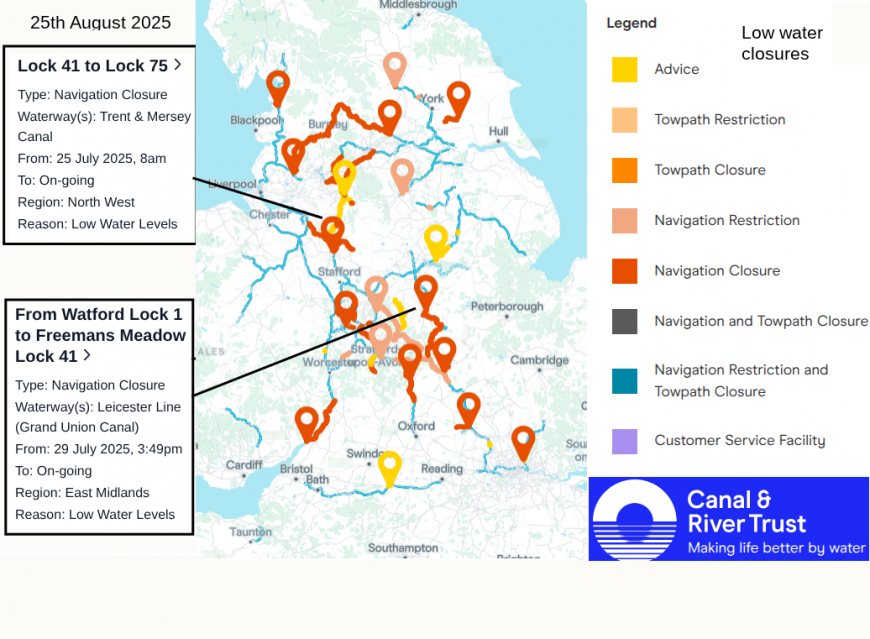
Matt - Netweather forum member and keen boater.
“The canals are pretty well stuffed this year in the East Midlands, Yorkshire into Lancashire and even Birmingham. Catastrophically low reservoir levels have meant that most of the major hire bases have either had to relocate or, as of Aug 26th, close. The canals are way down on normal levels, with no respite on the horizon. The links to the rivers Nene and Soar/Trent are also closed.”
The Canal & Rivers Trust network includes 82 reservoirs, and like those managed by the water companies, the levels are low. River-fed canals are also being impacted as river levels in England are falling.
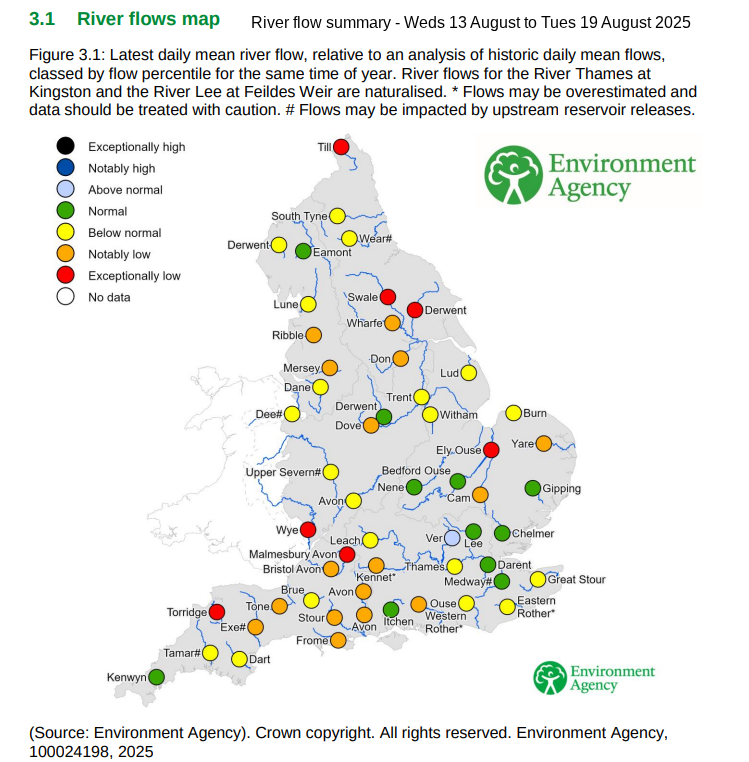
By the end of July 2025, five reservoir groups were at their lowest historical holding, (data since 1998, 13 groups). Some of the reservoirs had not started from full in winter due to engineering works that required the reservoirs to be held-down (maintained at less than full capacity) but the ongoing dry conditions and resulting drought have just been exceptional.
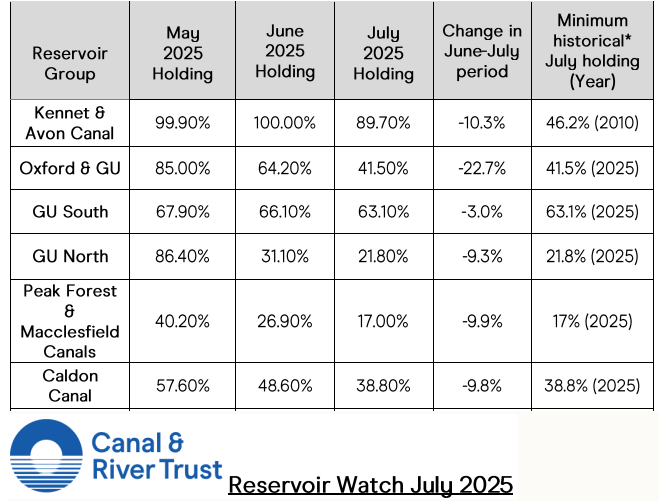
Decreased flow rates and water availability are affecting the navigability of the canal network. Canals have become unnavigable or inaccessible due to a combination of factors. It hasn’t rained in so long, surface water runoff is minimal, and they are reliant on water abstraction from sources that are now too low.
There hasn’t been significant rain for months, and with the hot, sunny weather, there has been a lot of evaporation. On a hot day, a canal can lose as much as an inch of water (2.5cm). There is always natural seepage of water and leaks through the lock gates.
The canal network has historically been used for irrigation then transport until the railways took over. Now its role is mainly for recreational boating, with many others making use of the towpaths as walking routes. There is a bit of freight transport where barges can fit, rather than just narrowboats. Currently, it is the lack of rainfall combined with hot and sunny weather that is seizing up parts of the network.
Back in the winter of 1962/63 it was the bitter cold and ice that hit transportation hard. There have been other times when too much water has brought problems in Britain with flooding of tow paths and moorings, even breaches of the canal walls.
Routinely, works are ongoing to restore and maintain the network and reservoir levels are managed to allow these works to continue. However, this year, due to the exceptional lack of rainfall, there are restrictions on the reservoirs and river abstractions are in place for many water users. There is just not enough water available to top up the canals.
‘Several lock flights across Birmingham have been closed to preserve water, including Brades, Minworth, Rushall and Tame Valley and Wolverhampton.’ Canal & River Trust.
Daniel Greenhalgh, CRT operations performance director and Chair of the water management steering group, spoke about the impacts of the drought this summer. About their maintenance programme, as their focus had to move, to managing the water and the drought impacts, along with assisting customer enquiries. Some repairs were taking place whilst the lock flights were closed, but trying to balance the system was the main workload.
Daniel also spoke about the traditional method of ‘ashing up the gates'. In the busy times of industrial use on the canal, this was done, through the lock flight, each night if water was in short supply, to prevent leakage. Ash is poured into the canal from just above the lock. The flow of water would suck the ash into any small gaps in the gates and make a water-tight seal. All of this is about keeping the available water in the ‘right’ places.
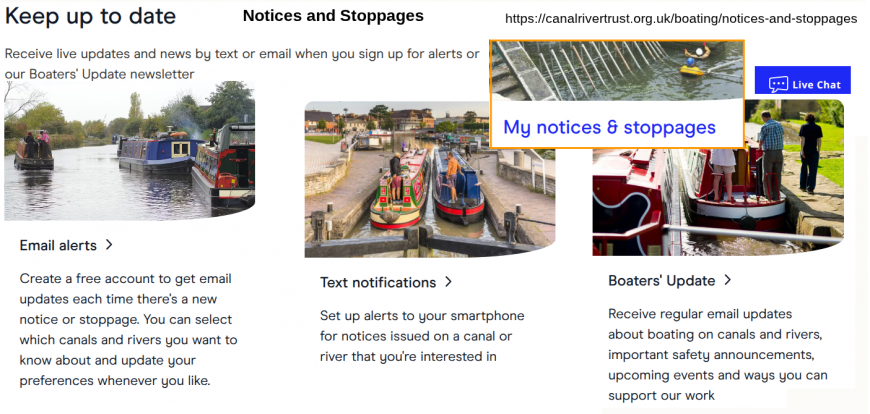
There are still some parts of the network without restrictions, but the Canal and River Trust has a plea to boaters to sign up for stoppage notices. These are alerts from the Trust and the fastest way to keep up to date.
Matt “Canals NOT affected tend to either source water from treatment station outflows or chalk aquifers such as the Lower Grand Union. The Leeds Liverpool/Rochdale/Huddersfield Narrow have been shut for most of the year already.
If you're a continuous cruiser, you need to move your boat regularly to stay within the terms of your licence. These low water restrictions are preventing movement and the CRT have explained that boaters should not be penalised due to navigation closures but do ask that if people are stuck in one place or are worried that 'movement pattern' might break the rules, then to contact them.
“Even the Gloucester & Sharpness is no longer open. CRT provide the water source for Gloucester and the Severn is very low (it's pumped up into Gloucester Dock and if too low, too much silt gets brought up).” Matt
Other impacts
Low flow conditions can reduce the natural transport of sediment through the system, potentially threatening the safety of navigation. Increased dredging can then be required. Another cost. Warming of the canal water can result in more algal blooms and other invasive plant species, so changes in the biodiversity of the waterways. Weeds are an ongoing issue.
‘Scottish Canals’ Navigation Score - July 2025 “We publish a navigation score as a guide to the likely weed burden in the channel and to indicate ease of passage. A high score = Lowland Canal Network has been cut within the last month. A low score = Part of the canal will be carrying a weed burden, which may impact on navigation. Lowland Canal Navigation Score = 98%”
Just has heavy rain and flooding can cause damage and erosion, long-term dryness and low water levels can cause shifts and instabilities to the canal structure and nearby ground.
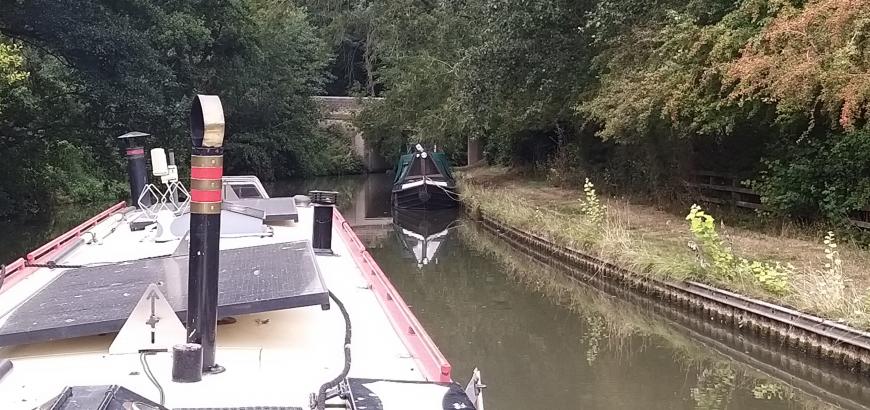
Bridgwater
The Inland Waterways Association (IWA) looks to protect and restore Britain’s network of canals and navigable rivers and is “the only independent, national charity campaigning for Britain’s canals and rivers”. Even events for funding the restoration and upkeep of canals have been hit by the lack of water this summer. A planned event this Bank Holiday weekend had to be cancelled due to low water levels and restricted access for the boats.
“ongoing closures, stoppages, and unpredictable water levels across the network, some of them in the last few days, have created significant challenges for boat movements and event planning. At a time when boaters were meant to be coming together, many are simply unable to get there.” IWA
Rallying for the Bridgewater Canal: A National Cause- united in support of restoring full navigation to the Bridgewater Canal. (Boating, Underfunding) “This event has been postponed to 2026 owing to water shortages on neighbouring networks”
You might remember the dramatic pictures from New Year’s Day 2025 when heavy rain caused a disastrous breach on the Bridgewater Canal, Cheshire. There was drone footage of the collapse and draining of huge amounts of water from the canal down the embankment, with water pouring into neighbouring fields, flooding a sewage works and leaving boats stranded in the canal for weeks. Ironically, an event caused by too much rain sees its campaign gathering postponed due to little rain.
Even as the UK weather begins to turn unsettled for the very end of August 2025, it will not be enough to release this situation. It is thought that some of the restrictions and closures could last until winter. Significant and sustained rainfall would be needed to refill the reservoirs and get some of the navigation back open. Till then, movements will be slow and need careful planning and water management.
The future
The canal network is old and costly. There is a lot of work by volunteers and enthusiasts, along with the organisations that oversee the waterways. There are always calls for more funding. On top of all this, there is the British weather as our climate changes. With warmer and drier summers, but heavier winter rainfall. Met Office
The Canal and River Trust has researched how climate change is likely to affect the canal network.
There will be future risks, “including flooding, drought, subsidence, structural damage and ecological degradation of our canal network.” The canal network does offer a lot, not just for leisure pursuits, and investment should stay under discussion and review.
Water transfer & supply: A crucial role in helping water companies with drinking water supplies and cooling for power stations. The canal network offers sustainable water transfer solutions that already exist.
Agricultural support, the canal network can provide surplus water to local farmers. This aids drought resilience and can help to safeguard food production.
Flood mitigation & relief as the canal network serves as an adaptable resource to mitigate extreme weather impacts and can be used to divert water away from heavily affected areas. An overflow system has been created through the Rochdale Canal, directing excess floodwater away from a village to a designated floodplain.
However, extreme weather is damaging the network with rising costs from flooding, subsidence damage and landslides. Canal culverts are also prone to collapse in stormy, wet weather. There are hundreds of culverts located underground, allowing water to pass from one place to another but the old structures are vulnerable to erosion.
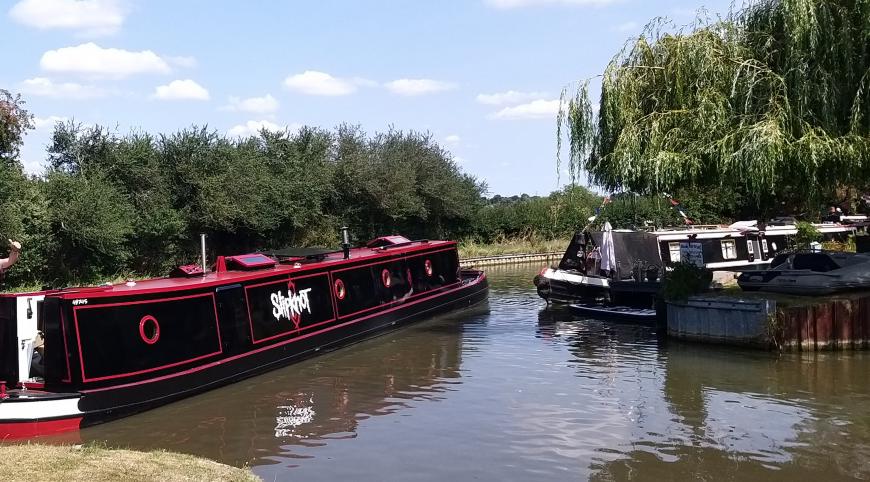
Heating, cooling & growth: Waterways in cities help reduce urban temperatures in times of heatwaves. Manchester’s waterfront bars are well known with canalside, quay and lock views and popular on sultry summer evenings. The canal network can provide opportunities for low-carbon heating and cooling of buildings and other infrastructure, such as for data centres. The canal network delivers attractive settings for sustainable urban living and provides beneficial services, such as active travel (cycling, walking) and urban cooling in our cities. Is it an underused transport option?
“While it is unlikely that the narrow canals of the Midlands will see much freight again, the larger waterways of the North East, Manchester Ship Canal and the major rivers where large barges can operate are where the real potential for growth lies…Barge transport is considerably more environmentally friendly than road or rail per tonne moved and helps to achieve the government’s net zero target. Moving goods by barge uses only 17% of the energy required to move goods by road, and 50% of the energy required to move goods by rail.“ Logistics
It would need bold thinking and a lot of investment, but something to ponder if you are walking along a towpath on a summer's evening, looking at the painted narrowboats.
Loading recent activity...